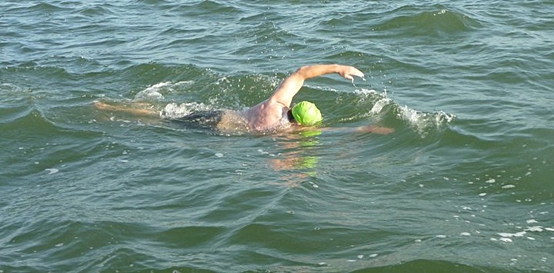|
Natural Health - Peak Performance - Longevity - Adventure
|
|
|

Swimming is the Perfect ExerciseSwimming is the perfect exercise, successfully utilizing every major muscle group in the body, including arms, shoulders, legs, and core. Moreover, it exercises muscle groups at little impact. Swimming lends itself well to interval training, effective for regulating heart rate and raising metabolism. Interval training can take many forms, including drills in which you sprint for 50 yards/meters and then coast for 50 yards/meters, or swimming a number of repeats (e.g., 10 x 50 yards/meters) on a fixed time interval that includes both the time for the swim and a short rest. Interval training can be as flexible and as challenging as your imagination. Open water swimming adds a new dimension of challenge. Pool swimming is all about eliminating variables, while open water swimming reintroduces them; wind, waves, cold, direction, and crowds. Those variables make the sport an altogether different one. Endurance open water swimming, like the English Channel Swim, adds even more challenge, adventure and rewards. English Channel Swim Training and ChallengesOpen water endurance swimming at the English Channel Swim level requires physical, mental, and nutritional endurance. You are training your body to become an engine that will run for 13 hours. This training takes ‘One Stroke at a Time’ and lots of patience. It is not uncommon for open water swimmers to plan one month per mile training schedules, training 24 months for a 24 mile swim. There are several reasons for this: (1) the stress on the body is minimized, (2) the acclamation period for the body to accept the workload is minimized, (3) a new diet of foods that are highly concentrated take a while for the body to adjust to, and (4) the impact of extended exposure to cold water (61°F/16°C) takes time. Physical Training. Physical training progresses from several thousand yards to consistently swimming 8000 yards or more per day. Consistent distance per hour in the pool is counted by hours and not yards. Mental Discipline. Learning to keep one’s head down despite being tired for extended periods of time, requires significant mental discipline. Cold Water Tolerance. Cold water endurance training teaches the body to function for extended periods of time to generate warmth as well as maintain the effort to swim. Strong mental discipline is required to learn you will not die. Cold water training feels like a large bucket of ice water is being poured over your head, but for 13 hours. Nutrition Demands of Open Water Endurance SwimmingNutritional endurance demands biochemical changes of your body. The basic calculation for the amount of calories burned while swimming is 2.93 calories per mile, per pound. I weigh 207 pounds, and therefore burn 14,556 calories in a 24-mile swim, (2.93 calories x 24 miles x 207 pounds = 14,556 calories). You must also add 10-15 percent of your burnt calorie total for the energy it takes your body to keep itself warm. In this case, adding another 1,500 calories. As you can imagine, it is difficult to eat 15,000 calories over a 13-hour period without training the stomach to handle this input. See Swimming Hydration and Electrolyte Strategies for Improved Performance and Muscle Cramp Prevention I can assure anyone that given the proper amount of time and dedication, you too can accomplish your open water swimming goals, including an English Channel Swim! About the English Channel SwimThe English Channel Swim begins either in Dover, England or at Cap Gris Nez, France, and at 21 miles (33.8 kilometers) is the narrowist distance between England and France. Tides, currents and weather can make the actual swim distance closer to 24 miles (38.6 kilometers). Water temperatures average 61°F/16°C degrees. The English Channel Swim has an interesting history. Matthew Webb became the first to make the crossing without the aid of artificial buoyancy. He started from the Admiralty Pier in Dover on August 25, 1875 and made the crossing in 21 hours and 45 minutes, despite challenging tides. It was not until September 6, 1911 when Thomas William Burgess became the second person to successfully make the crossing, making the crossing from Dover to Gris Nez in 22 hours and 35 minutes. The fastest men's swim was made by Petar Stoychev in 6:57 hours in 2007. The fastest women's swim was made by Yvetta Hlavácová in 7:25 hours in 2007 In 1927 the Channel Swimming Association and entrusted with the task of observing and authenticating all Cross-Channel Swims. True to the Swim's founding spirit, "No person in an attempt to swim the Channel shall use or be assisted by an artificial aid of any kind, but is permitted to grease the body before a swim, use goggles, wear one cap, nose clip, ear plugs and one costume." The swim costume/suit and hat shall be of a material not offering thermal protection or buoyancy and shall be sleeveless and legless. For more information about the English Channel Swim and its official rules See Channel Swimming Association or the Channel Swimming & Piloting Federation. Don Macdonald spent the last three years training for the English Channel Swim in August only to be thwarted by bad weather. Since then, Don has embarded on a larger and more ambitious goal that will take him around the world, back to the English Channel at some point, swimming one body of water at a time. Don has a 'One Stroke at a Time' theme and philosophy. More about Don Macdonald. <-- back to top |
Articles on Swimming
| |||||||||||||||||||